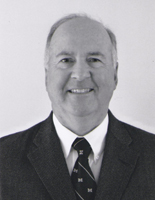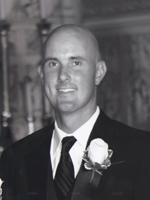 |
|||
 |
 |
 |
|
Bill Baum Midland |
Keith Bernacki Birmingham Seaholm |
Jim Niebling Portland |
|
(click on Inductee's name to read 'description')
 |
|||
 |
 |
 |
|
Bill Baum Midland |
Keith Bernacki Birmingham Seaholm |
Jim Niebling Portland |
|
(click on Inductee's name to read 'description')

 Bill Baum , Midland High School
Bill Baum , Midland High SchoolAt first glance, one might conclude that proximity is a major ingredient for successful high school tennis programs. Consider Holland, with its multitude of court complexes. How about Kalamazoo, with its storied Stowe Stadium and two colleges which field successful tennis teams. Same with Ann Arbor which not only has facilities but rubs up against inspiration in terms of a U of M tennis team that has captured no fewer than 36 Big Ten championships over the years. Same with Okemos which benefits from its proximity to MSU.
And then there is Midland, with its superb community tennis center. The splendor and scope of this venue brought the Class A/Division 1 Final Tournament to Midland starting in the spring of 1977. Given the facility, Midland has fielded excellent tennis teams at both Dow and Midland High ever since. Some have been state champions. You would think that the primary reason is the complex, which once housed our Hall of Fame display.
But it is easy to forget that people, not facilities, train tennis players. More to the point, at the end of a season we tend to lose sight of the fact that most of the best tennis teams are comprised of kids who learned the hard lessons of stroke production and competition before they got to high school. Somebody had to guide them.
In Midland’s case, many of those lessons came out of a junior high program coached by Bill Baum at West Central Intermediate. A math teacher at the school, his three letters as a varsity player at Escanaba High School convinced school officials to give him the job as junior high boys coach, a position he held from 1974 to 1980 and from 1996-1997. He added the girls job in 1974, overseeing the first interscholastic competition for any girls’ team at the school. Many of their matches were against high school JV teams such as Saginaw MacArthur, Mt. Pleasant, and Essexville Garber. For years, scores of successful Midland high school players came out of his middle school program.
In the fall of 2007, school officials moved the 9th grade into the high schools and since Bill was teaching freshman Algebra at Central, he transferred to Midland High School. With the influx of new students, a JV tennis team was created for both boys and girls.
Their coach was a good one. Over the years, his JV girls teams were 22-0-2; JV boys were 21-6-2. More to the point, these kids were well-trained and experienced when they advanced to the varsity.
So did Bill…advance to the varsity, that is. By then, he was a natural, exceptionally well prepared in terms of experience and expertise and a trusted quantity in the community.
The results show it. From 2001 to 2010, his boys varsity teams were 82-18. From 2000 to 2003 and again from 2008 to 2009, his girls varsity teams were 51-13. That’s a total of 133-31, an 81% win average. His boys and girls went to the state tournament six times, finishing as high 8th in 2005.
To achieve this Bill did the right things. He started a summer program called Tennis Tuesdays where anyone interested in playing tennis at Midland High School could hit from 7-9 p.m. on Tuesdays during the summer. He hosted regional tournaments, always an advantage in that it enables your kids to play this key tournament “at home.” He hosted the Saturday Midland Invitational every year for both boys and girls.
Perhaps more importantly, he was universally admired and respected by kids, colleagues, and parents. “I had an opportunity to visit with the team quite a bit today (Oct. 4, 2008),” as they used our van as a shelter from the cold,” said parent Joni Kaiser in a letter to Bill. “We could see you going from court to court and I made a comment to them that when they get older they will realize what a great coach you are. You would have been proud of the response. They replied that they already realized this and then searched for the right word to describe you. Some words were thrown out: sincere, caring, gentle, etc. but they all agreed that the best word is honorable.”
Essexville Garber’s Nancy Brissette summarizes Bill, using the word gentleman. “His rapport with his athletes, parents, and other coaches was something all coaches should strive for,” she says. “His sportsmanship was amazing. You could never tell whether Bill’s team is winning or losing. He radiated positive energy.”
“He was a low-key coach who encouraged his players with a quiet enthusiasm,” says Saginaw Heritage’s Bob Quinn. “His players were always ladies and gentlemen on and off the court, which is an indication of the type of things Bill required of his players.”
One day at the end of practice, Bill’s 2001 Girls Varsity team sent him back to his classroom on a trumped-up errand. There he found a list of “50 Things We Love About Mr. Baum” printed on the blackboard. Among them were “His 15 more minutes….. it means 30.” Also, “His advice at change-overs,” “His door o’ stats,” and his “ability to apply math to everything.”
So let’s do the math: Bill coached a total of 58 tennis teams (this is not a misprint).
If proximity is a reason why Holland high school tennis has been so successful, it is as much the work of the four coaches who are in our Hall of Fame as the facilities that the community offers. If proximity is the reason why the Kalamazoo area programs are so successful, so is the work of the four coaches who are in the Hall of Fame. Bill joins an august group in that he becomes the third coach from the Midland area to be inducted into our Hall of Fame.
| Back to Top |
 Keith Bernacki, Birmingham Seaholm High School
Keith Bernacki, Birmingham Seaholm High School“He never used his illness as leverage,” says Seaholm assistant coach Paul Young. “In fact, it was just the opposite. He often told me of the calls he got from the media wanting to do a story about him and Seaholm tennis, but he always deflected the questions away from himself and focused the interview on the team.”
“Those who were around him were amazed at his resilience and how he handled the debilitating disease,” continues Paul, who was assistant to Keith Bernacki for 13 years and our association’s Assistant Coach of the Year in 2008. “In later years, I had to start practice several times while he was finishing his treatments, but he would then arrive, ready to coach, as if nothing was wrong.”
Keith was an all-state doubles player and all-state soccer player at Brother Rice during his own high school years. But while a freshman at the University of Michigan in 1997, he was diagnosed with Ewing’s sarcoma, a rare type of bone cancer. After a year of intense chemo and radiation, he was cancer free for 3 ½ years. Then it metastasized to his lungs. Thereafter he fought off repeated recurrences, enduring as many as 70 weeks of chemotherapy over the years. But more than one parent, colleague, or player has said, “His determination not to let illness define him left an unshakable impression.”
“Partly it’s everything he goes through and partly the way he treats people,” said player Jamie Wilkie back in 2005. “He’s more than just a coach to all of us. We know when he’s going through chemo, but we can’t tell the difference between a bad week and when he’s having a good week. He’s great all the time.”
To be sure, there have been plenty of good weeks in terms of wins and losses. During his eight seasons, his girls won one state championship (2004) and finished second in the state twice (2005 and 2006) in the five seasons that he coached the Maple girls. His boys teams were state runners-up twice in consecutive seasons (2007 and 2008), losing the state title by one point in a tournament which came down to the final match. That was the year he was honored by our association with a State Coach of the Year award.
In 13 seasons, Keith’s boys and girls teams qualified for state competition 11 times. Under his guidance the Maples were league champions five times and regional champions seven times. They finished in the top ten of the state 10 times. “As North Farmington’s Mark Shenton has said, “His players were good to go from the first point, and if yours were not, the first set would be done in a hurry.”
But as the poet Rudyard Kipling once declared, triumphs and disasters are imposters, a truth that Keith personified. “He taught my son that a player who could not take a loss with the same grace as with a win was not someone he could respect,´ says Sara Cullen, mother of star player Casey. “He gave my son the finest example of what it is to be a man.”
“He taught them, and us, so many things,” says parent Nancy Green, who undoubtedly has an appreciation of metaphor. “Don’t dwell on past mistakes, or things you can’t control. If you play a lousy point, or if someone makes a bad call, just move on without regret. I can still hear Keith’s voice saying: ‘Next point.’”
“He was the toughest competitor I have ever met,” says David Reed-Norwall, a fellow English teacher at Seaholm and a soccer coach. “He was also the most honorable. I have heard people complain about little things. I never once heard any from Keith.”
“He greatly influenced the young people he came in contact with,” says Paul. “He truly connected with them, as evidenced by the number of ex-players who stayed in touch with him and who often returned to tennis matches to say hello, long after they had moved on in life.”
When word got out about his death in February, 2011, a former player, Jake Drutchas, set up a Facebook page entitled
RIP Bernacki. In 24 hours, more than 100 – former players, opposing coaches, former English students, parents -- had joined the group.
More than one declared: “I hope your son grows up to be just like you.”
More than one declared: “Being with you was a gift.”
More than one declared: I wrote this note with tears streaming down my face.”
“I am privileged to have witnessed your great example first hand,” wrote Linda Proctor Steward, parent
“He rallied around his tennis teams with boisterous energy and a quiet magic,” wrote Cathy R. Brown, parent
“When Keith was honored by the MHSTeCA with a 2008 Coach of the Year Award, our parents had a sign created,” says athletic director Aaron Frank. “It was hung at our courts next to the signs which list the team championships.
“Keith saw the sign that afternoon and came right to my office. He asked me to remove it. I explained to him that our parents did it because they wanted to honor him. He told me that he coached the students. He was uncomfortable with any personal recognition, and he insisted that it be removed.
“I rehung that sign after Keith’s memorial service, and I think it would be appropriate to hang a new sign right next to that one – Keith Bernacki, Michigan High School Tennis Coaches Hall of Fame.”
Amen
| Back to Top |
 Jim Niebling , Portland High School
Jim Niebling , Portland High SchoolAt the end of each season, Jim Niebling prepares a “Yearbook” for his team. It is an impressive document. It lists match records, historical achievements, and a summary of each senior’s accomplishments. It contains a list of tournament wins and season records. It contains team pictures and individual photos of the seniors. It has an impressive cover and team pictures of both the varsity and the JV. Each match record is accompanied by Jim’s extensive commentary regarding the contest. Historic milestones and team achievements are highlighted. Statistics are extensive (individuals, matches played, matches won, percentages). Varsity award winners throughout history include Most Valuable, Outstanding Leader, Most Dedicated, Most Improved, Rookie of the Year, and Coach’s Award (presented by the coaching staff to a player whose contribution to the success of the team is immeasurable). Each senior is treated to a portrait and a summary. The season results, including tournaments, are summarized. A listing of Portland varsity letter winners, organized by one year through four year letter-winners, is presented.
“For the past 22 years, I have done nearly all of the marketing,” explains Jim, and indeed, there is much to highlight. During this time span, his teams have accumulated a 154-56-20 record with 61 tournament titles. His boys have won three regional titles, seven league championships, and qualified for the state tournament 12 of the 15 years that the sport has been school sponsored. His girls have won only one regional title, qualified once, and won the league four times, “but they’ve had several undefeated seasons,” he hastens to add. “We did send our #1 singles player to the state finals without her team five other times.”
Jim exemplifies the classic Hall of Fame tennis coach who starts a program from nothing and by sheer will, hard work, and love of the game builds it into a force. “In my tenure as coach, I’ve seen the program grow from used balls in five-gallon buckets to 10.
A high school player for Hall of Fame coach Harley Pierce at Sturgis, Jim was asked to start a tennis club in his fourth year of teaching at Portland High School. He formed a co-ed team and called local athletic directors seeking matches with area JV squads. That summer he started a tennis camp, doing everything: marketing, administrating, and teaching. He received help from Sue Selke at Court One Athletic Club and Hall of Famer Marty Snoap at Lake Odessa Lakewood. “All I know is that I didn’t have a clue what I was doing,” he says, “so I was very lucky to have the support of parents and grandparents, none of whom knew anything about tennis but knew there was something of value getting started so they wanted to see it grow.”
Grow, indeed. By the second year, there were enough kids playing on both the boys and girls clubs to fill a complete varsity lineup and almost a JV as well. In the summer, the classes grew from a few kids in each camp to over 30. Although it took three more years (politics to blame) for the school board to sanction tennis as an interscholastic sport, the seeds were planted. “They didn’t think Portland High School, a small rural school of a little more than 500 students back then, could handle it,” says Jim.
How wrong they were. As North Muskegon’s Greg Wieman once said: “You may beat Jim, but you won’t outwork him.” By the fifth summer, the program was seeing nearly 150 players. “It was a complete program that might rival a small racket club that had definitely become a community program,” Jim says.
Jim also successfully pushed for better facilities. “We started with six courts with a wood-plank bridge that crossed a cesspool between the parking lot and the courts,” he says. “Today we have one of the best facilities in the area: 10 courts, a PA system, a very functional storage facility, restrooms, and a pavilion.” Jim is especially proud of the 10’ tall, 120’ long hitting wall, complete with Portland Tennis and a PT logo emblazoned on it. “It’s so big you can probably see it from outer space,” he says. “I wanted everyone to know we were here.”
They know ... especially Portland’s opponents. A look at a Portland Tennis Yearbook is eloquent testimony And as Williamston’s Steve Stanley has metaphorically explained: “Jim Niebling is a tale of two serves. He has a fierce first serve when the matches are underway. No one is more competitive, strategic, alert, and engaged when the ball is in play and a match is in the balance.
“Then there is Jim’s second serve,” adds Steve, “for when the match is over and Jim shifts from winning for his team to the health of high school tennis.” Indeed, for years he has hosted scores of invitationals and 19 regional tournaments on Portland’s fine facilities. He has never missed a Detroit workshop and once served on a panel discussion there entitled “Coaching a Successful Program.” He serves on the MHSTeCA Board of Directors where he is in charge of organizing the Assistant Coach of the Year and Distinguished Service Award selection process. He helps out area coaches in the summer, providing among other things , match competition for their kids.
He is certainly not an unknown quantity. Jim has been named regional coach of the year 11 times and state boys coach of the year twice, once in 2003 and again in 2010. All honoring a guy who started a program from scratch.
Time for one more honor. |
Time for one more honor. |
| Back to Top |